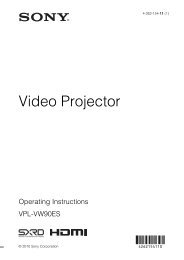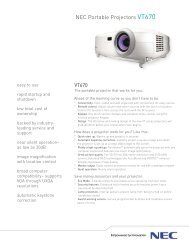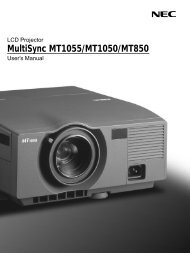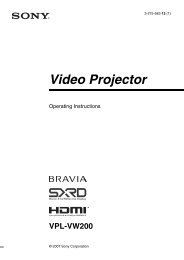CLM HD8 - Projector Central
CLM HD8 - Projector Central
CLM HD8 - Projector Central
Create successful ePaper yourself
Turn your PDF publications into a flip-book with our unique Google optimized e-Paper software.
5. Connections<br />
RS232<br />
An Electronic Industries Association (EIA) serial digital interface standard specifying the characteristics of the communication<br />
path between two devices using either D-SUB 9 pins or D-SUB 25 pins connectors. This standard is used for<br />
relatively short-range communications and does not specify balanced control lines. RS-232 is a serial control standard<br />
with a set number of conductors, data rate, word length and type of connector to be used. The standard specifies component<br />
connection standards with regard to computer interface. It is also called RS-232-C, which is the third version<br />
of the RS-232 standard, and is functionally identical to the CCITT V.24 standard. Logical ’0’ is > + 3V, Logical ’1’ is < -<br />
3V. The range between -3V and +3V is the transition zone.<br />
RS422<br />
An EIA serial digital interface standard that specifies the electrical characteristics of balanced (differential) voltage,<br />
digital interface circuits. This standard is usable over longer distances than RS-232. This signal governs the asynchronous<br />
transmission of computer data at speeds of up to 920,000 bits per second. It is also used as the serial port<br />
standard for Macintosh computers. When the difference between the 2 lines is < - 0.2V that equals with a logical ’0’.<br />
When the difference is > +0.2V that equals to a logical ’1’..<br />
Ethernet network communication<br />
The <strong>CLM</strong> projector can be connected to a LAN (local area network) using the Ethernet port (E) on the communication interface. Once<br />
connected to the LAN, users are capable of accessing the projector from any location, inside or outside (if allowed) their company<br />
network using the <strong>CLM</strong> control software: <strong>Projector</strong> Toolset. This toolset locates the projector on the network in case there is a DHCP<br />
server or the user can insert the correct IP-address of the projector to access the projector. Once accessed, it is possible to check<br />
and manipulate all the projector settings. Remote diagnostics, control and monitoring of the projector can then become a daily and<br />
very simple operation. The network connectivity permits to detect potential errors and consequently improve the time to servicing.<br />
Both Ethernet port (E) is equipped with a yellow and green a LED. The yellow LED lights up in case the port is connected with a<br />
100Mbit network. The green LED blinks in case there is network activity.<br />
The connector used for the Ethernet ports (E) are of rugged Neutrik EtherCon RJ45 type, which is compatible<br />
with standard RJ45 cable connector. Straight (most common) as well as cross linked network cables can be<br />
used.<br />
Pin<br />
10/100 Base-T — RJ45 port<br />
Description<br />
1 TXD+<br />
2 TXD-<br />
3 RXD+<br />
4 —<br />
5 —<br />
6 RXD-<br />
7 —<br />
8 —<br />
USB port<br />
The communication interface is equipped with a master USB port, type “A” connector (H). This USB port will simplify the service<br />
procedures for software updates or for taking backup files from the projector without network connection. An USB-stick is plugged<br />
into the USB port and files can be transferred from or to the projector using the local or remote control unit. Note that the USB-stick<br />
has to be Linux FAT16 compatible.<br />
DMX interface<br />
The communication interface of the <strong>CLM</strong> <strong>HD8</strong> supports DMX.<br />
DMX is used as communication bus between different devices in the light technic. Each device has an input and an output, so that<br />
the bus can be looped between the different devices. According the standard a five wire cable with XLR connector is used but mostly<br />
3-wire cables are used.<br />
You can use the DMX input port (G) to connect a DMX device to the <strong>CLM</strong> projector. This way you can control the <strong>CLM</strong> projector<br />
from that DMX device. The DMX output port (G) can be connected with the next device in the loop.<br />
Pin<br />
Description<br />
1 Earth<br />
R59770057 <strong>CLM</strong> <strong>HD8</strong> 15/03/2010 41
















